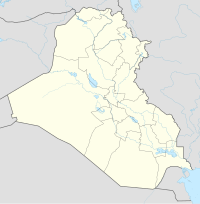Tell el-'Oueili
| Location | Iraq |
|---|---|
| Region | Dhi Qar Governorate |
| Coordinates | 31°14′35″N 45°53′06″E / 31.243°N 45.885°E |
| Type | settlement |
| Length | 200 metres (660 ft) |
| Height | 5 metres (16 ft) |
| History | |
| Abandoned | before 3000 BCE |
| Periods | Ubaid |
| Site notes | |
| Excavation dates | 1976, 1978, 1981, 1983, 1985, 1987, 1989 |
| Archaeologists | A. Parrot. J.-L. Huot |
Tell el-'Oueili is a tell, or ancient settlement mound, located in Dhi Qar Governorate, southern Iraq. The site was excavated between 1976 and 1989 by French archaeologists under the direction of Jean-Louis Huot. The excavations have revealed occupation layers predating those of Eridu, making Tell el-'Oueili the earliest known human settlement in southern Mesopotamia.
History of research
The site was first noted and surveyed by French scholar André Parrot, who at the time was working at nearby Larsa.[1] Two small excavation seasons took place in 1976 and 1978, and regular excavations commenced in 1981.[2] Four more seasons took place in every uneven year until 1989. All excavations were directed by French archaeologist Jean-Louis Huot.[3]
Tell el-'Oueili and its environment
The site measures 200 metres (660 ft) in diameter and is approximately 5 metres (16 ft) high.[1] It is located ca. 3.5 kilometres (2.2 mi) southeast of Larsa in Dhi Qar Governorate, southern Iraq. The environment of 'Oueili is characterized by temperatures that can reach more than 50º C in summer and less than 250 mm of annual rainfall, making the area unsuitable for rainfed agriculture.[4]
Occupation history
Tell el-'Oueili was occupied during the Ubaid period. The excavations have revealed occupation layers dating from Ubaid 0 (6500-5400 BCE) to Ubaid 4. The phase Ubaid 0 was first discovered at this site and was hence provisionally termed 'Oueili-phase.[2]
See also
References
- ^ a b Huot, J.-L. (1980), "Tell el'Oueili (Iraq): les Premiers Résultats", Paléorient (in French), 6 (1): 207–211, doi:10.3406/paleo.1980.4270, retrieved 2 August 2011
- ^ a b Huot, J.-L. (1985), "Tell el'Oueili. Principaux Résultats de la Quatrième Campagne (1983)", Paléorient (in French), 11 (1): 119–123, doi:10.3406/paleo.1985.4367, retrieved 2 August 2011
- ^ Vallet, R.; Huot, J.-L. (1990), "Les Habitations à salles hypostyles d'époque Obeid 0 de Tell El'Oueili", Paléorient (in French), 16 (1): 125–130, doi:10.3406/paleo.1990.4527, retrieved 2 August 2011
- ^ Huot, J.-L. (1985a), "Travaux en basse Mésopotamie. Les fouilles françaises à Larsa et 'Oueili", Comptes-rendus des séances de l'Académie des Inscriptions et Belles-Lettres (in French), 129 (2): 300–318, doi:10.3406/crai.1985.14270, retrieved 2 August 2011

